View in other NatureServe Network Field Guides
NatureServe
Montana
Utah
Wyoming
Idaho
Wisconsin
British Columbia
South Carolina
Yukon
California
New York
Canvasback - Aythya valisineria
Native Species
Global Rank:
G5
State Rank:
S5B
(see State Rank Reason below)
Agency Status
USFWS:
MBTA
USFS:
BLM:
PIF:
External Links
State Rank Reason (see State Rank above)
Species is common, widely distributed, and stable.
General Description
An exclusively North American species. Gregarious and highly visible during the nonbreeding season. The Canvasback is a large diving duck. Male (51 to 56 cm/863 to 1589 g) slightly larger than female (48 to 52 cm/908 to 1543 g). Thin wedge-shaped head sloping upward from tip of long bill to back of crown and long, stout neck, head held erect. Adult male: rich chestnut red head and neck, black chest, white back and long sloping, blackish bill. Adult female: forehead, crown, nape and upper neck light brown to brownish olive; cheeks, chin and throat whitish buff; lower neck gray-brown, with reddish-brown cast. Mantle and scapulars light gray, lower back and rump grayish; belly white to grayish white; bill nearly black (Mowbray 2002).
For a comprehensive review of the conservation status, habitat use, and ecology of this and other Montana bird species, please see
Marks et al. 2016, Birds of Montana.Species Range
Montana Range
Range Descriptions
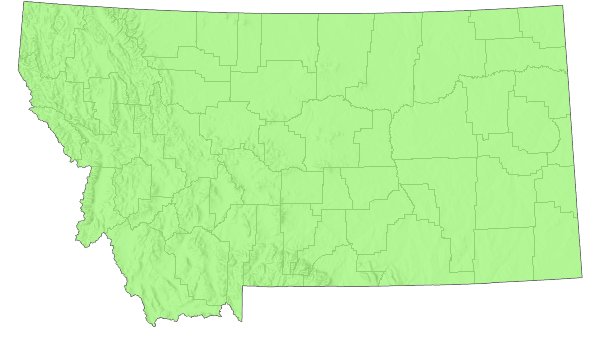 Western Hemisphere Range
Western Hemisphere Range
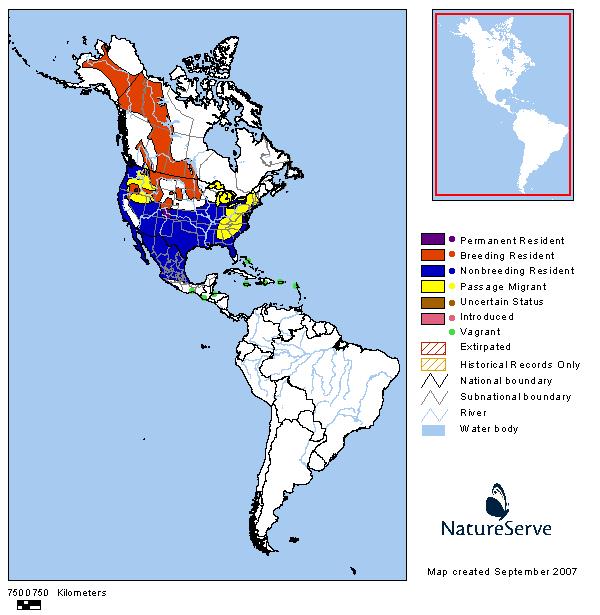
Observations in Montana Natural Heritage Program Database
Number of Observations: 6338
(Click on the following maps and charts to see full sized version)
Map Help and Descriptions
Relative Density
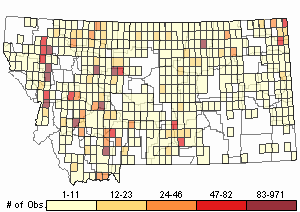
Recency
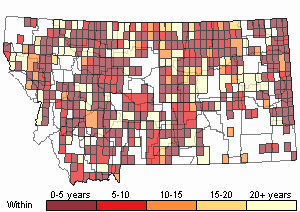
SUMMER (Feb 16 - Dec 14)
Direct Evidence of Breeding

Indirect Evidence of Breeding

No Evidence of Breeding

WINTER (Dec 15 - Feb 15)
Regularly Observed

Not Regularly Observed

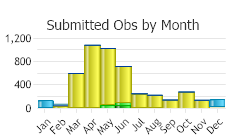
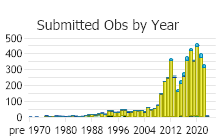
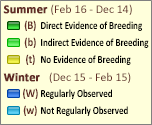 (Observations spanning multiple months or years are excluded from time charts)
(Observations spanning multiple months or years are excluded from time charts)
Migration
Normal migration periods in the Bozeman area are from March 28 to May 20 and from September 20 to December 1, with peak numbers on April 15 and October 15.
Habitat
Breeds in small lakes, deep-water marshes, sheltered bays of large fresh water and alkali lakes, permanent and semi permanent ponds, sloughs, potholes, and shallow river impoundments. In aspen parklands and mixed-grass prairie, prefers wetlands bordered by dense emergent vegetation. In boreal forest, utilizes open marshes (Mowbray 2002).
National Vegetation Classification System Groups Associated with this Species
Forest and Woodland
Deciduous Forest and Woodland
Wetland and Riparian
Alkaline - Saline Wetlands
Alpine Riparian and Wetland
Peatland
Riparian and Wetland Forest
Riparian Shrubland
Wet Meadow and Marsh
Food Habits
Omnivorous. Foods vary depending upon availability. During winter and migration, mainly plants (winter buds, rhizomes, and tubers or aquatic plants). When plant food is limited, may take small clams and snails (Mowbray 2002).
Ecology
At Bowdoin National Wildlife Refuge in April 1948, 5000 were seen. At Freezeout Lake, all nests in emergent vegetation were unsuccessful due to flooding.
Reproductive Characteristics
Monogamous and secretive during the breeding season. Nest is a large bulky structure. May be overtopped by vegetation and may have one or more well-maintained ramps. Eggs are elliptical to elliptical-ovate. Grayish olive or greenish drab in color. Clutch size is affected by egg parasitism. Size is widely variant (2 to 16) as a result (Mowbray 2002). The nesting period is from late May through July. Hatching at Freezeout Lake was from June 1 to July 31; hatching dates are from May 21 to June 30.
Stewardship Responsibility
References
- Literature Cited AboveLegend:
 View Online Publication
View Online Publication Marks, J.S., P. Hendricks, and D. Casey. 2016. Birds of Montana. Arrington, VA. Buteo Books. 659 pages.
Marks, J.S., P. Hendricks, and D. Casey. 2016. Birds of Montana. Arrington, VA. Buteo Books. 659 pages. Mowbray, T. B. 2002. Canvasback (Aythya valisinaria). In The birds of North America, No. 659 (A. Poole and F. Gill, Eds.). Academy of Natural Sciences of Philadelphia and American Ornithologists’ Union.
Mowbray, T. B. 2002. Canvasback (Aythya valisinaria). In The birds of North America, No. 659 (A. Poole and F. Gill, Eds.). Academy of Natural Sciences of Philadelphia and American Ornithologists’ Union.
- Additional ReferencesLegend:
 View Online Publication
View Online Publication
Do you know of a citation we're missing? [WWPC] Washington Water Power Company. 1995. 1994 wildlife report Noxon Rapids and Cabinet Gorge Reservoirs. Washington Water Power Company. Spokane, WA.
[WWPC] Washington Water Power Company. 1995. 1994 wildlife report Noxon Rapids and Cabinet Gorge Reservoirs. Washington Water Power Company. Spokane, WA. American Ornithologists’ Union [AOU]. 1998. Check-list of North American birds, 7th edition. American Ornithologists’ Union, Washington, D.C. 829 p.
American Ornithologists’ Union [AOU]. 1998. Check-list of North American birds, 7th edition. American Ornithologists’ Union, Washington, D.C. 829 p. Butler, M.A. 1996. The validity of using artificial nests to assess nest-predation rates in prairie nesting ducks. M.Sc. Thesis. Bozeman, MT: Montana State University. 82 p.
Butler, M.A. 1996. The validity of using artificial nests to assess nest-predation rates in prairie nesting ducks. M.Sc. Thesis. Bozeman, MT: Montana State University. 82 p. Confluence Consulting Inc. 2010. Montana Department of Transportation Wetland Mitigation Monitoring Reports (various sites). MDT Helena, MT.
Confluence Consulting Inc. 2010. Montana Department of Transportation Wetland Mitigation Monitoring Reports (various sites). MDT Helena, MT. Cornely, J.E. 1982. Waterfowl production at Malheur National Wildlife Refuge, 1942-1980. Transactions of the 47th North American Wildlife and Natural Resources Conference. pp 559-571.
Cornely, J.E. 1982. Waterfowl production at Malheur National Wildlife Refuge, 1942-1980. Transactions of the 47th North American Wildlife and Natural Resources Conference. pp 559-571. ECON, Inc. (Ecological Consulting Service), Helena, MT., 1977, Colstrip 10 x 20 Area wildlife and wildlife habitat annual monitoring report, 1977. Proj. 164-85-A. December 31, 1977.
ECON, Inc. (Ecological Consulting Service), Helena, MT., 1977, Colstrip 10 x 20 Area wildlife and wildlife habitat annual monitoring report, 1977. Proj. 164-85-A. December 31, 1977. ECON, Inc. (Ecological Consulting Service), Helena, MT., 1979, Annual wildllife report of the Colstrip Area for 1979, including a special raptor research study. Proj. 216-85-A. March 1, 1980.
ECON, Inc. (Ecological Consulting Service), Helena, MT., 1979, Annual wildllife report of the Colstrip Area for 1979, including a special raptor research study. Proj. 216-85-A. March 1, 1980. Ehrlich, P., D. Dobkin, and D. Wheye. 1988. The birder’s handbook: a field guide to the natural history of North American birds. Simon and Schuster Inc. New York. 785 pp.
Ehrlich, P., D. Dobkin, and D. Wheye. 1988. The birder’s handbook: a field guide to the natural history of North American birds. Simon and Schuster Inc. New York. 785 pp. Ellig, L.J. 1953. Waterfowl relationships to Greenfields Lake, Teton County, Montana. M.Sc. Thesis. Bozeman, MT: Montana State University. 49 p.
Ellig, L.J. 1953. Waterfowl relationships to Greenfields Lake, Teton County, Montana. M.Sc. Thesis. Bozeman, MT: Montana State University. 49 p. Gjersing, F.M. 1971. A study of waterfowl production on two rest rotation grazing units in northcentral Montana. M.Sc. Thesis. Bozeman, MT: Montana State University. 42 p.
Gjersing, F.M. 1971. A study of waterfowl production on two rest rotation grazing units in northcentral Montana. M.Sc. Thesis. Bozeman, MT: Montana State University. 42 p. Gjersing, F.M. 1975. Waterfowl production in relation to rest-rotation grazing. Journal of Range Management 28:37-42.
Gjersing, F.M. 1975. Waterfowl production in relation to rest-rotation grazing. Journal of Range Management 28:37-42. Gniadek, S. 1983. Southwest Glendive Wildlife Baseline Inventory. Miles City, Mont: Bureau of Land Management, Miles City District Office. 56 pp with appendices.
Gniadek, S. 1983. Southwest Glendive Wildlife Baseline Inventory. Miles City, Mont: Bureau of Land Management, Miles City District Office. 56 pp with appendices. Golden Sunlight Mines, Inc. 2000. Golden Sunlight Mines, Inc., Whitehall, MT. Annual Permit Reports.
Golden Sunlight Mines, Inc. 2000. Golden Sunlight Mines, Inc., Whitehall, MT. Annual Permit Reports. Goodell, J. 2012. Morse Land Company Breeding Bird Inventory And Analysis. High Desert Museum. Bend, OR. 42 pp + Appendices.
Goodell, J. 2012. Morse Land Company Breeding Bird Inventory And Analysis. High Desert Museum. Bend, OR. 42 pp + Appendices. Hays, R., R.L. Eng, and C.V. Davis (preparers). 1984. A list of Montana birds. Helena, MT: MT Dept. of Fish, Wildlife & Parks.
Hays, R., R.L. Eng, and C.V. Davis (preparers). 1984. A list of Montana birds. Helena, MT: MT Dept. of Fish, Wildlife & Parks. Hildebrand, B. D. 1979. Habitat requirements of molting Canada Geese at Lima Reservoir, Montana. M.Sc. Thesis. Bozeman, MT: Montana State University. 79 p.
Hildebrand, B. D. 1979. Habitat requirements of molting Canada Geese at Lima Reservoir, Montana. M.Sc. Thesis. Bozeman, MT: Montana State University. 79 p. Johnsgard, P.A. 1979. Birds of the Great Plains: breeding species and their distribution. University of Nebraska Press, Lincoln. 539 pp.
Johnsgard, P.A. 1979. Birds of the Great Plains: breeding species and their distribution. University of Nebraska Press, Lincoln. 539 pp. Johnsgard, P.A. 1992. Birds of the Rocky Mountains with particular reference to national parks in the northern Rocky Mountain region. Lincoln: University of Nebraska Press. xi + 504 pp.
Johnsgard, P.A. 1992. Birds of the Rocky Mountains with particular reference to national parks in the northern Rocky Mountain region. Lincoln: University of Nebraska Press. xi + 504 pp. Johnson, D.H. and J.W. Grier. 1988. Determinants of breeding and distributions of ducks. Wildl. Monogr. 100: 1-37.
Johnson, D.H. and J.W. Grier. 1988. Determinants of breeding and distributions of ducks. Wildl. Monogr. 100: 1-37. Johnson, D.H., M.C. Hammond, T.L. McDonald, C.L. Nustad and M.D. Schwartz. 1989. Breeding canvasbacks: A test of a habitat model. Prairie Nat. 21(4): 193-202.
Johnson, D.H., M.C. Hammond, T.L. McDonald, C.L. Nustad and M.D. Schwartz. 1989. Breeding canvasbacks: A test of a habitat model. Prairie Nat. 21(4): 193-202. Joslin, Gayle, and Heidi B. Youmans. 1999. Effects of recreation on Rocky Mountain wildlife: a review for Montana. [Montana]: Montana Chapter of the Wildlife Society.
Joslin, Gayle, and Heidi B. Youmans. 1999. Effects of recreation on Rocky Mountain wildlife: a review for Montana. [Montana]: Montana Chapter of the Wildlife Society. Knight, R.R. 1960. Vegetative characteristics of two water areas in Teton County, Montana, in relation to waterfowl usage. M.Sc. Thesis. Bozeman, MT: Montana State University. 38 p.
Knight, R.R. 1960. Vegetative characteristics of two water areas in Teton County, Montana, in relation to waterfowl usage. M.Sc. Thesis. Bozeman, MT: Montana State University. 38 p. Knight, R.R. 1965. Vegetative characteristics and waterfowl usage of a Montana water area. J. Wildl. Manage. 29(4):782-788.
Knight, R.R. 1965. Vegetative characteristics and waterfowl usage of a Montana water area. J. Wildl. Manage. 29(4):782-788. Korschgen, C.E., and R.B. Dahlgren. 1992. Human disturbances of waterfowl: causes, effects, and management. Ch. 13.2.15 In: Waterfowl Management Handbook. Fish and Wildlife Service Leaflet. 8 p.
Korschgen, C.E., and R.B. Dahlgren. 1992. Human disturbances of waterfowl: causes, effects, and management. Ch. 13.2.15 In: Waterfowl Management Handbook. Fish and Wildlife Service Leaflet. 8 p. Lenard, S., J. Carlson, J. Ellis, C. Jones, and C. Tilly. 2003. P. D. Skaar's Montana bird distribution, 6th edition. Montana Audubon, Helena, MT. 144 pp.
Lenard, S., J. Carlson, J. Ellis, C. Jones, and C. Tilly. 2003. P. D. Skaar's Montana bird distribution, 6th edition. Montana Audubon, Helena, MT. 144 pp. Lorang, K.D. 1979. Waterfowl and hunter use of Freezeout Lake Game Management Area. M.Sc. Thesis. Bozeman, Montana: Montana State University. 79 p.
Lorang, K.D. 1979. Waterfowl and hunter use of Freezeout Lake Game Management Area. M.Sc. Thesis. Bozeman, Montana: Montana State University. 79 p. Maxon, S.J. and M.R. Riggs. 1996. Habitat use and nest success of overwater nesting ducks in westcentral Minnesota. J. Wildl. Manage. 60(1): 108-119.
Maxon, S.J. and M.R. Riggs. 1996. Habitat use and nest success of overwater nesting ducks in westcentral Minnesota. J. Wildl. Manage. 60(1): 108-119. Miller, M.G. 1980. The influence of habitat features on waterfowl productivity on stock reservoirs in south Valley County, Montana. M.Sc. Thesis. Bozeman, MT: Montana State University. 43 p.
Miller, M.G. 1980. The influence of habitat features on waterfowl productivity on stock reservoirs in south Valley County, Montana. M.Sc. Thesis. Bozeman, MT: Montana State University. 43 p. Montana Bird Distribution Committee. 2012. P.D. Skaar's Montana bird distribution. 7th Edition. Montana Audubon, Helena, Montana. 208 pp. + foldout map.
Montana Bird Distribution Committee. 2012. P.D. Skaar's Montana bird distribution. 7th Edition. Montana Audubon, Helena, Montana. 208 pp. + foldout map. Mundinger, J.G. 1975. The influence of rest-rotation grazing management on waterfowl production on stock-water reservoirs in Phillips County, Montana. M.Sc. Thesis. Bozeman, MT: Montana State University. 100 p.
Mundinger, J.G. 1975. The influence of rest-rotation grazing management on waterfowl production on stock-water reservoirs in Phillips County, Montana. M.Sc. Thesis. Bozeman, MT: Montana State University. 100 p. Oechsli, L.M. 2000. Ex-urban development in the Rocky Mountain West: consequences for native vegetation, wildlife diversity, and land-use planning in Big Sky, Montana. M.Sc. Thesis. Montana State University, Bozeman. 73 p.
Oechsli, L.M. 2000. Ex-urban development in the Rocky Mountain West: consequences for native vegetation, wildlife diversity, and land-use planning in Big Sky, Montana. M.Sc. Thesis. Montana State University, Bozeman. 73 p. Palmer, R.S. 1962. Handbook of North American birds. Volume 1. Loons through flamingos. Yale University Press, New Haven. 567 pp.
Palmer, R.S. 1962. Handbook of North American birds. Volume 1. Loons through flamingos. Yale University Press, New Haven. 567 pp. Prellwitz, D. M. 1987. Canvasback nesting on man-made islands in Montana. Prairie Naturalist 19:101-102.
Prellwitz, D. M. 1987. Canvasback nesting on man-made islands in Montana. Prairie Naturalist 19:101-102. Rhodes, O.E., Jr., L.M. Smith and M.H. Smith. 1991. Conservation and genetic resources in waterfowl. Trans. N. Amer. Wildl. & Nat. Res. Conf. 56:462-472.
Rhodes, O.E., Jr., L.M. Smith and M.H. Smith. 1991. Conservation and genetic resources in waterfowl. Trans. N. Amer. Wildl. & Nat. Res. Conf. 56:462-472. Rundquist, V.M. 1973. Avian ecology on stock ponds in two vegetational types in north-central Montana. Ph.D. Dissertation. Bozeman, MT: Montana State University. 112 p.
Rundquist, V.M. 1973. Avian ecology on stock ponds in two vegetational types in north-central Montana. Ph.D. Dissertation. Bozeman, MT: Montana State University. 112 p. Saunders, A.A. 1914. The birds of Teton and northern Lewis & Clark counties, Montana. Condor 16:124-144.
Saunders, A.A. 1914. The birds of Teton and northern Lewis & Clark counties, Montana. Condor 16:124-144. Sibley, D. 2014. The Sibley guide to birds. Alfred A. Knopf, New York, NY. 598 pp.
Sibley, D. 2014. The Sibley guide to birds. Alfred A. Knopf, New York, NY. 598 pp. Skaar, P. D., D. L. Flath, and L. S. Thompson. 1985. Montana bird distribution. Montana Academy of Sciences Monograph 3(44): ii-69.
Skaar, P. D., D. L. Flath, and L. S. Thompson. 1985. Montana bird distribution. Montana Academy of Sciences Monograph 3(44): ii-69. Skaar, P.D. 1969. Birds of the Bozeman latilong: a compilation of data concerning the birds which occur between 45 and 46 N. latitude and 111 and 112 W. longitude, with current lists for Idaho, Montana, Wyoming, impinging Montana counties and Yellowstone National Park. Bozeman, MT. 132 p.
Skaar, P.D. 1969. Birds of the Bozeman latilong: a compilation of data concerning the birds which occur between 45 and 46 N. latitude and 111 and 112 W. longitude, with current lists for Idaho, Montana, Wyoming, impinging Montana counties and Yellowstone National Park. Bozeman, MT. 132 p. Stewart, R. E., and H. A. Kantrud. 1973. Ecological distribution of breeding waterfowl populations in North Dakota. Journal of Wildlife Management 37(1):39-50.
Stewart, R. E., and H. A. Kantrud. 1973. Ecological distribution of breeding waterfowl populations in North Dakota. Journal of Wildlife Management 37(1):39-50. Stewart, R.E. and H.A. Kantrud. 1972. Population estimates of breeding birds in North Dakota. The Auk 89(4):766-788.
Stewart, R.E. and H.A. Kantrud. 1972. Population estimates of breeding birds in North Dakota. The Auk 89(4):766-788. Stewart, R.E. and H.A. Kantrud. 1974. Breeding waterfowl populations in the Prairie Pothole Region of North Dakota. Condor 76: 70-79.
Stewart, R.E. and H.A. Kantrud. 1974. Breeding waterfowl populations in the Prairie Pothole Region of North Dakota. Condor 76: 70-79. Thompson, L.S. 1981. Circle West wildlife monitoring study: Third annual report. Technical report No. 8. Montana Department of Natural Resources and Conservation. Helena, Montana.
Thompson, L.S. 1981. Circle West wildlife monitoring study: Third annual report. Technical report No. 8. Montana Department of Natural Resources and Conservation. Helena, Montana. U.S. Forest Service. 1991. Forest and rangeland birds of the United States: Natural history and habitat use. U.S. Department of Agriculture, Forest Service Agricultural Handbook 688. 625 pages.
U.S. Forest Service. 1991. Forest and rangeland birds of the United States: Natural history and habitat use. U.S. Department of Agriculture, Forest Service Agricultural Handbook 688. 625 pages. Waldt, R. 1995. The Pine Butte Swamp Preserve bird list. Choteau, MT: The Nature Conservancy. Updated August 1995.
Waldt, R. 1995. The Pine Butte Swamp Preserve bird list. Choteau, MT: The Nature Conservancy. Updated August 1995. Watts, C.R. and L.C. Eichhorn. 1981. Changes in the birds of central Montana. Proceedings of the Montana Academy of Sciences 40:31-40.
Watts, C.R. and L.C. Eichhorn. 1981. Changes in the birds of central Montana. Proceedings of the Montana Academy of Sciences 40:31-40.
- Web Search Engines for Articles on "Canvasback"
- Additional Sources of Information Related to "Birds"





